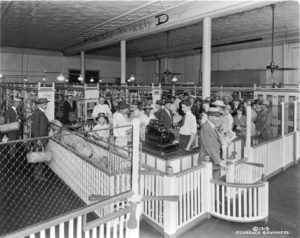Good morning, Whitewater.
Tuesday in town will be partly cloudy with a high of eighty-nine. Sunrise is 6:26 AM and sunset is 7:19 PM, for 12h 52m 36s of daytime. The moon is a waxing crescent with 22.6% of its visible disk illuminated.
Whitewater’s Alcohol Licensing Committee meets at 6:15 PM, and her Common Council at 6:30 PM.
A century ago, on this day in 1916, Piggly Wiggly opens the first self-service grocery in America:
Piggly Wiggly was the first true self-service grocery store.[3] It was founded on September 6, 1916, at 79 Jefferson Avenue in Memphis, Tennessee, by Clarence Saunders. A replica of the original store has been constructed in the Memphis Pink Palace Museum and Planetarium, a mansion that Saunders built as his private residence, which was later sold to the city.
The origin of the name “Piggly Wiggly” is unknown. When asked why he had chosen it, Saunders said “So people will ask that very question”. Theories include Saunders seeing some pigs struggling to get over a fence, or a reference to the “This Little Piggy” nursery rhyme.[4]
At the time of its founding, grocery stores did not allow their customers to gather their own goods. Instead, a customer would give a list of items to a clerk, who would then go through the store himself, gathering them. Like full-service gas stations, this created a greater cost, therefore higher prices. Piggly Wiggly introduced the innovation of allowing customers to go through the store, gathering their own goods. This cut costs, allowing for lower prices.[5] Others were initially experimenting with this format as well, which initially came to be known as a “grocerteria”, reminding people of cafeterias, another relatively new, self-service idea.[6]
Piggly Wiggly Corporation secured the self-service format and issued franchises to hundreds of grocery retailers for the operation of its stores. The concept of the “self-serving store” was patented[7] by Saunders in 1917. Customers at Piggly Wiggly entered the store through a turnstile and walked through four aisles to view the store’s 605 items sold in packages and organized into departments. The customers selected merchandise as they continued through the maze to the cashier. Instantly, packaging and brand recognition became important to companies and consumers.
JigZone today offers a puzzle of a window:


Shop the Pig!